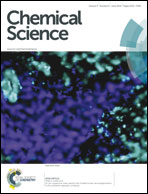Roles of carboxylate donors in O–O bond scission of peroxodi-iron(iii) to high-spin oxodi-iron(iv) with a new carboxylate-containing dinucleating ligand†
Abstract
Dioxygen activation proceeds via O–O bond scission of peroxodi-iron(III) to high-spin oxodi-iron(IV) in soluble methane mono-oxygenase (sMMO). Recently, we have shown that reversible O–O bond scission of peroxodi-iron(III) to high-spin oxodi-iron(IV) is attained with a bis-tpa type dinucleating ligand, 6-hpa. In this study, a new carboxylate-containing dinucleating ligand, 1,2-bis[2-(N-2-pyridylmethyl-N-glycinylmethyl)-6-pyridyl]ethane (H2BPG2E) and its μ-oxodiaquadi-iron(III) complexes [Fe2(μ-O)(H2O)2(BPG2E)]X2 [X = ClO4 (2a) or OTf (2b)] were synthesized to mimic a common carboxylate-rich coordination environment in O2-activating non-heme di-iron enzymes including sMMO. The crystal structures of 2a and 2b revealed that BPG2E prefers a syn-diaqua binding mode. 2b catalyzed the epoxidation of alkenes with H2O2. A new purple species was formed upon reaction of 2b with H2O2, and characterized by the elemental analysis and spectral and kinetic studies. These clearly showed that the purple species was a μ-oxo-μ-peroxodi-iron(III), and converted to high-spin μ-oxodioxodi-iron(IV) via rate-determining reversible O–O bond scission. In comparison of BPG2E with 6-hpa, it is shown that the carboxylate donor stabilizes the Fe–O–O–Fe structure of the peroxo complex due to the structural effect to retard O–O bond scission. This may shed light on the roles of carboxylate donors in the dioxygen activation of non-heme di-iron enzymes.


 Please wait while we load your content...
Please wait while we load your content...